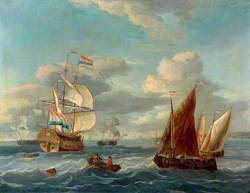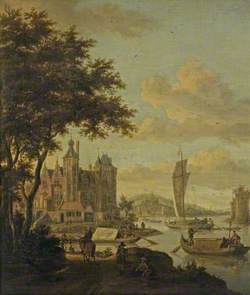How you can use this image
This image can be used for non-commercial research or private study purposes, and other UK exceptions to copyright permitted to users based in the United Kingdom under the Copyright, Designs and Patents Act 1988, as amended and revised. Any other type of use will need to be cleared with the rights holder(s).
Review the copyright credit lines that are located underneath the image, as these indicate who manages the copyright (©) within the artwork, and the photographic rights within the image.
The collection that owns the artwork may have more information on their own website about permitted uses and image licensing options.
Review our guidance pages which explain how you can reuse images, how to credit an image and how to find images in the public domain or with a Creative Commons licence available.
Notes
Add or edit a note on this artwork that only you can see. You can find notes again by going to the ‘Notes’ section of your account.
This Italianate harbour view is one of the many Mediterranean depictions painted by Abraham Storck from 1665 onwards. In the foreground he has depicted a quay, with an antique obelisk and fountain, surrounded by colourful figures. Behind the quay on the left is a prestigious ‘classicised’ building with a monumental staircase, crowned with a few Classical sculptures. To the right is an imposing two-decker, which is perhaps preparing to leave the harbour, as well as a galley heading seaward. However much Storck gives the impression of an everyday scene, the architectural context is not based on reality. The monumental building’s façade is reminiscent of a Venetian palazzo or a villa from the surroundings of Rome. Storck probably worked from prints of existing buildings but diverged from them.
In the seventeenth century antique obelisks on a limestone base, as depicted here, could be found in the Piazza del Popolo in Rome among other places. The most famous granite obelisks lacking hieroglyphs are those found in the Piazza dell’Esquilino and the Piazza del Quirinale. In this last square can also be found the Dioscuri, the horse-tamers Castor and Pollux, on which Storck based the athletic figures with their horses at the top of the staircase. The staffage around the obelisk and the fountain indicates trade activity in the harbour. Lying by the quayside is a sloop adorned with a Dutch flag, in which a man blows a trumpet, probably to announce the ship’s approaching departure. Clothed in black and carrying a sword in its sheath, a captain negotiates with a few oriental merchants.
Built in the Dutch style, the warship carries the centuries-old Jerusalem cross, with four small red crosses between the arms of a large red cross on a white field. A large red ensign flies on the stern, depicting a standing golden lion with right paw raised.
Title
Italianate Harbour View with a Fantasy Building and Man-of-War
Date
1697
Medium
oil on canvas
Measurements
H 76 x W 91.5 cm
Accession number
BHC0929
Work type
Painting








